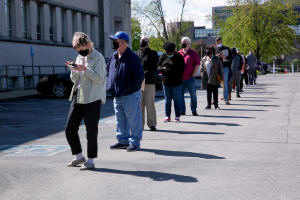Could Fed's 'softening' labor market prediction mean 4 million lost
jobs?
 Send a link to a friend
Send a link to a friend
 [August 29, 2022] By
Howard Schneider [August 29, 2022] By
Howard Schneider
JACKSON HOLE, Wyo. (Reuters) - In 2019, the
U.S. unemployment rate averaged 3.7% and consumer prices rose at an
annual rate of around 1.8%.
Fast forward to 2022, and while the unemployment rate has averaged the
same 3.7% for the first seven months of the year, prices are
sky-rocketing at an annual rate of more than 8% - touching off a
potentially intense debate at the Federal Reserve over whether the "hot"
labor market policies embraced before the COVID-19 pandemic can survive
in the economy that is emerging.
U.S. central bank officials acknowledge their battle to tame raging
inflation is likely to cost jobs as rising interest rates slow the
economy and companies retool staffing plans in response, though whether
the loss of employment will be modest or massive is unknown.
More contentious: Whether the combination of a tight job market and high
inflation is a coincidence of the pandemic or a sign that labor and the
economy have changed in fundamental ways that mean efforts to control
inflation may require higher unemployment than before.

That's a controversial issue. When Gita Gopinath, the first deputy
managing director at the International Monetary Fund, suggested at this
year's Jackson Hole central banking conference that hot labor market
policies now carried a risk of higher prices, there was quick pushback.
Today's U.S. job market "isn't hot. This is a raging inferno," said
Minneapolis Fed President Neel Kashkari, arguing that efforts to curb
the imbalances don't mean officials need to forever abandon monetary
policies meant to coax more workers into the labor force and push
unemployment lower.
St. Louis Fed President James Bullard countered that the Fed should be
cautious in assuming indicators like the labor force participation rate
should always go higher.
"People do value leisure and you want them to get the right tradeoff,"
he said.
In the wake of the pandemic, it remains an open question whether those
preferences have changed.
There's growing evidence they did. Retirements rose, and while some
retirees went back to work, not all did. Labor force participation for
younger workers remains lower than pre-pandemic levels as well.
Recent research has suggested a decline also in the hours people want to
work.
The implication is the economy may remain labor-constrained, with
continued pressure on wages, and that for any given unemployment rate
there may be even less available labor than headline numbers indicate.
For the current inflation debate, that may mean that policymakers have
to accept a relatively larger rise in joblessness if they wish to lower
the rises in prices.

In the Fed's most recent economic projections, the median estimate
tagged a long-run unemployment rate of 4% as consistent with inflation
at the central bank's 2% target. Joblessness is seen increasing as part
of the inflation battle, but only gradually to 3.7% by the end of this
year, 3.9% next year, and 4.1% in 2024 - in effect a "soft landing" for
the job market in response to the highest inflation and most aggressive
interest rate increases in 40 years.
Many analysts regard that outlook as too optimistic, and argue that the
Fed will need to create much more economic slack - lower demand and
slower growth - to get the needed response on prices. That may mean
broader job losses.
'A LITTLE PREMATURE'
The Labor Department on Friday will issue its employment report for
August, with analysts polled by Reuters forecasting that the
unemployment rate will remain unchanged at 3.5%. Less than three weeks
later, Fed policymakers will issue new economic projections at their
Sept. 20-21 meeting.
[to top of second column] |

People line up outside a newly reopened
career center for in-person appointments in Louisville, U.S., April
15, 2021. REUTERS/Amira Karaoud/File Photo

One estimate from San Francisco Fed economists posited that an unemployment rate
consistent in the short-run with lower inflation to be as high as 6%. That would
imply roughly 4 million lost jobs.
"Economic disruptions appear to have pushed up the short-run noninflationary
rate substantially," the research concluded.
There are contrary theories. If inflation is driven less by resource slack,
including labor, and more by recent global supply problems or by public
expectations, it may come under control with minimal job losses.
That case has been argued by Fed Governor Christopher Waller. In a recent paper,
he concluded that shifts in the relationship between job openings and
joblessness may mean a drop in vacancies could do much to ease labor market
pressure - a point rebutted by former U.S. Treasury Secretary Lawrence Summers'
projections of a sharp rise in unemployment.
Fed Chair Jerome Powell stuck with the euphemistic "some softening of labor
market conditions" in his keynote speech on Friday at the Jackson Hole
conference in Wyoming as he promised a tough fight against inflation.
Cleveland Fed President Loretta Mester told Reuters in an interview that the
unemployment rate may only need to rise as high as 4.25%.
"I don't think anybody can be very precise now about where the sustainable rate
of unemployment is," she said on the sidelines of the Jackson Hole conference on
Saturday. If there was a wide range before, there is a wider range now because
of the nature of work changing ... But it is a little premature to say we have
to get unemployment up to 6%. That is not in my forecast."
There also is a longer-run consideration for the Fed. Under Powell, the Fed
conceded that in the past it had sometimes overstated the risk of inflation, and
kept monetary policy stricter than necessary at a cost of needless unemployment.

To avoid that error, the Fed adopted a new strategy in 2020 that pledged to
fight "shortfalls of employment from its maximum level." In practice, that meant
looser policy that took greater risks with inflation in favor of pushing up
employment - the very hot labor market strategy Gopinath warned about.
There was a sense at the time that the unemployment rate consistent with low
inflation had fallen far below Fed estimates, and ignoring that to chase phantom
inflation would foster unnecessary joblessness.
The unresolved issue now is whether that so-called "natural" rate of
unemployment has risen either temporarily or permanently, and whether tradeoffs
between inflation and unemployment - thought to have faded as a concern - will
now bind policymakers.
"People are concerned that these tradeoffs will be more pointed ... There are
still unresolved pandemic issues layered on top of the long-run demographics,"
that would tend to decrease labor force participation, said Janice Eberly, an
economist at Northwestern University. "Nobody really wants to put a stake in the
ground on what the unemployment rate is going to look like in the long run."
(Additional reporting by Ann Saphir; Editing by Dan Burns and Paul Simao)
[© 2022 Thomson Reuters. All rights
reserved.]This material may not be published,
broadcast, rewritten or redistributed.
Thompson Reuters is solely responsible for this content.
 |